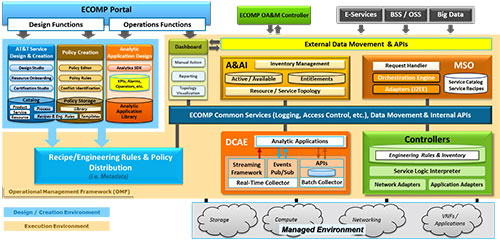AT&T’s ECOMP (Enhanced Control, Orchestration, Management and Policy) is the “brain” providing the lifecycle management and control of our software-centric network resources, infrastructure and services. Recently, Chris Rice, our VP of AT&T Labs took a deeper look at ECOMP. Today, I’ll give you an overview of ECOMP’s architecture. To appreciate what drove the definition of the ECOMP architecture and its functions, I’ll start with the drivers of the AT&T Software-defined Networking (SDN), Network Function Virtualization (NFV) and cloud efforts.
When the software-centric network effort began, we had already been adopting cloud technology, primarily on IT or corporate applications. Cloud technology provided the ability to manage diverse workloads of applications dynamically, including:
- Creating Virtual Machines (VMs) on hardware in near real time
- Assigning applications and workloads to VMs in near real time
- Dynamically moving applications and dependent functions to different VMs across various locations
- Dynamically controlling resources available to applications (CPU, memory, storage)
At the same time, we were working to virtualize network functions by transforming network appliances into software applications that run in the cloud.
In the software-centric network, the real-time cloud capabilities discussed above are applied to applications like virtual network functions (vNFs). This applies the benefits of the cloud to virtual network elements. For example, vNFs, such as routers, switches, firewalls, can be “spun up” on commodity hardware, moved from one data center to another center dynamically and resources like CPU, memory and storage can be modified in near real time.
AT&T has defined three key objectives across our network virtualization initiatives:
- Improve cycle time
- Open our network
- Increase efficiency
To achieve these goals, we needed new processes. We had to rethink service creation, development, automation, product/service instantiation and life cycle management. ECOMP rapidly onboards new services customers want and cuts operating and capital costs through these 2 frameworks: Design Time Framework, which provides metadata-driven service design and creation capabilities and Runtime Execution Framework, which provides real-time, policy-driven automation of network management functions.

ECOMP Design Time Framework has 3 aspects:
- AT&T Service Design & Creation
- Policy Creation
- Analytic Applications Design
Together, these areas create relationships between services, analytics and policies to publish, together or separately. The Run Time Execution Framework instantiates and provides the orchestration, data collection, analytics and policies based on metadata from the Design Time Framework. Real-time, closed-loop automation occurs through data collection, analytics and policies that define the actions needed based on the results of analytics. This closed loop mechanism brings near real time control and lifecycle management of the software-centric network services and resources. Automation is the result.
ECOMP is a reusable platform of software assets and will be used widely across AT&T. Stay tuned for future discussion of ECOMP’s 7 major platform components.
AT&T Service Design and Creation (ASDC) – Provides a well-structured organization of visual design & simulation tools, templates and catalogs to model and create resources, services and products.
Master Service Orchestration (MSO) – Arranges, sequences and implements tasks based on policies and rules/recipes to coordinate the creation, modification or removal of logical and physical resources in the managed environment.
Data Collection, Analytics and Events (DCAE) – Provides real-time fault, performance, event and other data collection, correlation & analysis to manage service, network and infrastructure health and support closed loop automation.
Policy – Modifiable Rules, Assertions and/or Conditions to enable real-time decision making on corrective actions and configuration changes in the software-centric network ecosystem.
Active and Available Inventory (A&AI) – tracks the dynamic relationships of virtualized networks, services & resources, their relationships and status to maintain ECOMP platform integrity and the global inventory it manages.
SDN & Application Controller – SDN Controllers configure, monitor and maintain the health of network services and elements throughout their lifecycle. Application Controllers configure, monitor and maintains the health of an applications throughout their lifecycle.
ECOMP Portal – Provides a common portal framework and UI architecture for creating and operating virtual infrastructure and services. Examples of capabilities include: Common look and feel, role administration, access control, SDK with plug-ins and web components.

Take a look at our ECOMP white paper. We also want to hear your feedback – click here to send us your thoughts.
Paul Bartoli leads AT&T’s ECOMP (Enhanced Control, Orchestration, Management and Policy) Architecture organization at AT&T. The team is responsible for the definition of the ECOMP Framework, Platform architecture, its constituent components and their capabilities, Technical Roadmaps, as well as OSS transformation and BSS evolution to support AT&T’s software-centric network and service virtualization initiatives.

– See more at: http://about.att.com/innovationblog/041116ecomparchitect#sthash.SPMNffz3.dpuf
PR Archives: Latest, By Company, By Date